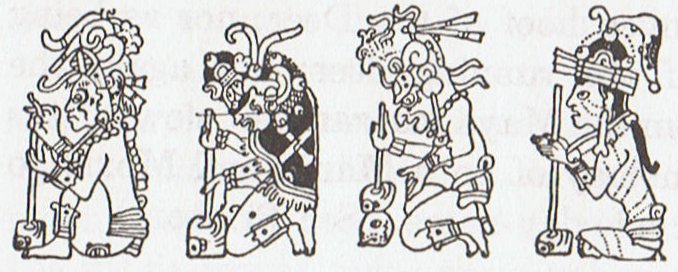2. The sections building up the new 'bamboo tree' were from different kinds of trees. This agrees with what is told in the myth about Maui playing with fire: ... Before the events that are related in this story Mahuika alone possessed the gift of fire, and all fire in the world was got from her. After Maui had tricked her, fire was kept in the wood of certain trees, from which men were able to release it ... I suggest the 3 'fire feathers' inside the 'tree' (henua) at spring equinox is an example of such a tree which like kaikomako had agreed to keep the fire:
... Even Mahuika herself almost perished before she could reach her place of shelter, and her shrieks were as loud as those of Maui when he was scorched. The waters rose all around her, and in this way Mahuika was deprived of her former power. But fire was saved for the world. When the waters reached her tikitiki, or the topknot of her head, the last seeds of fire fled from it to the rata , the hinau, the kahikatea, the rimu, and certain other trees. These trees would not admit them, and so they went to the mahoe, the totara, the patete, the pukatea, and the kaikomako, where they were cherished. These are the trees from whose dry wood fire can be obtained by friction. The others are of no use for this purpose ... There are 5 such 'fire trees'. In the henua calendar on the G tablet there is no kiore+henua glyph designed with 'fire inside'. Possibly it means the 'water' (flood) which threatened to drown the whole world referred to the southern path of the Milky Way between Cancer and Scorpio. ... The distance from Ka1-7 - with the same kind of horizontal internal marks - to Ka4-10 is 72 - 7 = 65 glyphs, which suggests the distance from Ka4-10 to Ka1-7 could be 300 days. 216 + 300 = 516 and 516 - 365 = 151:
'May 31 is Gregorian day 151 and this indicates the glyphs on the K tablet indeed represent days (because 216 + 300 - 365 = 151) ...
South of the equator Serpent would be high up in the sky and the Milky Way would be like a band of ghosts centered at Raven. Instead of 4 sky pillars north of the equator, which could be the proper design for keeping 'earth' above in place,
there could south of the equator have been necessary to have a single very tall one.
In rongorongo times the manzil Murzim (referring to Sirius, Te Pou) was beginning when ν Cancri rose heliacally 136.0 days counted from 'March 21. ... Counting from 'January 1 in the previous year 'August 7 will be day number 365 + 219 = 584 = the number of nights in the synodical cycle of Venus, the planet ruling births ... | ||||||||||||||||||||||||||||||||||||||||||||||||





